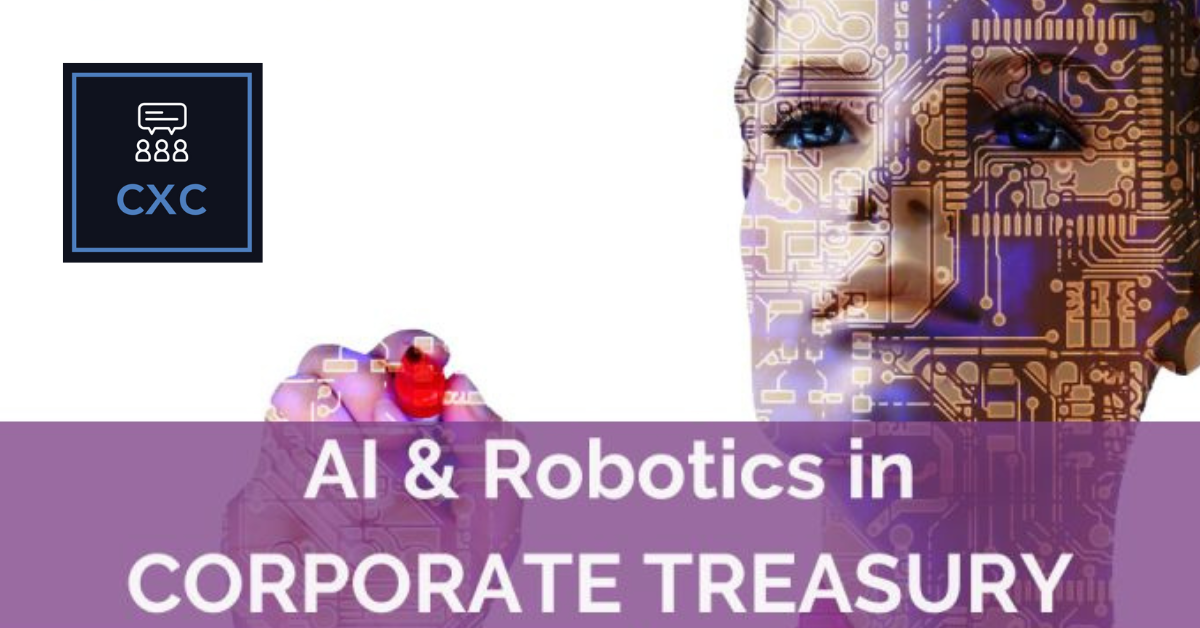AI & Robotics in Corporate Treasury
By ComplexCountries
12/06/2023
How corporate treasurers are using AI and Robotics – a detailed report produced by ComplexCountries

Can’t get enough? Check out these latest items
 https://treasuryxl.com/wp-content/uploads/2024/01/Template_VACANCY-featured.png
200
200
treasuryXL
https://treasuryxl.com/wp-content/uploads/2018/07/treasuryXL-logo-300x56.png
treasuryXL2025-07-18 07:00:522025-07-15 12:00:53Vacature Senior Financial Risk Manager – Utrecht
https://treasuryxl.com/wp-content/uploads/2024/01/Template_VACANCY-featured.png
200
200
treasuryXL
https://treasuryxl.com/wp-content/uploads/2018/07/treasuryXL-logo-300x56.png
treasuryXL2025-07-18 07:00:522025-07-15 12:00:53Vacature Senior Financial Risk Manager – Utrecht https://treasuryxl.com/wp-content/uploads/2022/09/ACT-commodities.png
200
200
treasuryXL
https://treasuryxl.com/wp-content/uploads/2018/07/treasuryXL-logo-300x56.png
treasuryXL2025-07-17 14:51:592025-07-17 14:51:59Tax and Treasury Intern @ ACT
https://treasuryxl.com/wp-content/uploads/2022/09/ACT-commodities.png
200
200
treasuryXL
https://treasuryxl.com/wp-content/uploads/2018/07/treasuryXL-logo-300x56.png
treasuryXL2025-07-17 14:51:592025-07-17 14:51:59Tax and Treasury Intern @ ACT https://treasuryxl.com/wp-content/uploads/2025/07/InCorpe.png
200
200
treasuryXL
https://treasuryxl.com/wp-content/uploads/2018/07/treasuryXL-logo-300x56.png
treasuryXL2025-07-17 10:24:302025-07-17 10:24:30Senior Analist Corporate Finance @ InCorpe
https://treasuryxl.com/wp-content/uploads/2025/07/InCorpe.png
200
200
treasuryXL
https://treasuryxl.com/wp-content/uploads/2018/07/treasuryXL-logo-300x56.png
treasuryXL2025-07-17 10:24:302025-07-17 10:24:30Senior Analist Corporate Finance @ InCorpe https://treasuryxl.com/wp-content/uploads/2025/04/Treasury-Spring-van-Template-2.png
200
200
treasuryXL
https://treasuryxl.com/wp-content/uploads/2018/07/treasuryXL-logo-300x56.png
treasuryXL2025-07-17 07:00:002025-07-14 13:56:49From Game Boys to AI: How technology is transforming treasury
https://treasuryxl.com/wp-content/uploads/2025/04/Treasury-Spring-van-Template-2.png
200
200
treasuryXL
https://treasuryxl.com/wp-content/uploads/2018/07/treasuryXL-logo-300x56.png
treasuryXL2025-07-17 07:00:002025-07-14 13:56:49From Game Boys to AI: How technology is transforming treasury https://treasuryxl.com/wp-content/uploads/2024/08/Surecomp-BLOGS-featured-3.png
200
200
treasuryXL
https://treasuryxl.com/wp-content/uploads/2018/07/treasuryXL-logo-300x56.png
treasuryXL2025-07-16 07:00:022025-07-14 10:12:47AI in Trade Finance: From Automation to Transformation
https://treasuryxl.com/wp-content/uploads/2024/08/Surecomp-BLOGS-featured-3.png
200
200
treasuryXL
https://treasuryxl.com/wp-content/uploads/2018/07/treasuryXL-logo-300x56.png
treasuryXL2025-07-16 07:00:022025-07-14 10:12:47AI in Trade Finance: From Automation to Transformation https://treasuryxl.com/wp-content/uploads/2023/03/Treasurer-Search-Logo.png
200
200
treasuryXL
https://treasuryxl.com/wp-content/uploads/2018/07/treasuryXL-logo-300x56.png
treasuryXL2025-07-15 13:20:492025-07-17 10:27:10Senior Financial Risk Manager – Utrecht @ Treasurer Search
https://treasuryxl.com/wp-content/uploads/2023/03/Treasurer-Search-Logo.png
200
200
treasuryXL
https://treasuryxl.com/wp-content/uploads/2018/07/treasuryXL-logo-300x56.png
treasuryXL2025-07-15 13:20:492025-07-17 10:27:10Senior Financial Risk Manager – Utrecht @ Treasurer Search https://treasuryxl.com/wp-content/uploads/2024/10/Embat-BLOGS-featured-2.png
200
200
treasuryXL
https://treasuryxl.com/wp-content/uploads/2018/07/treasuryXL-logo-300x56.png
treasuryXL2025-07-15 07:00:292025-07-14 09:39:46The art and science of building a financial team
https://treasuryxl.com/wp-content/uploads/2024/10/Embat-BLOGS-featured-2.png
200
200
treasuryXL
https://treasuryxl.com/wp-content/uploads/2018/07/treasuryXL-logo-300x56.png
treasuryXL2025-07-15 07:00:292025-07-14 09:39:46The art and science of building a financial team https://treasuryxl.com/wp-content/uploads/2024/10/Carlo-_BLOGS-Expert-featured-2.png
200
200
treasuryXL
https://treasuryxl.com/wp-content/uploads/2018/07/treasuryXL-logo-300x56.png
treasuryXL2025-07-14 08:34:312025-07-14 08:34:31Banks and Stablecoins: a first step towards bridging traditional finance and the crypto world
https://treasuryxl.com/wp-content/uploads/2024/10/Carlo-_BLOGS-Expert-featured-2.png
200
200
treasuryXL
https://treasuryxl.com/wp-content/uploads/2018/07/treasuryXL-logo-300x56.png
treasuryXL2025-07-14 08:34:312025-07-14 08:34:31Banks and Stablecoins: a first step towards bridging traditional finance and the crypto world https://treasuryxl.com/wp-content/uploads/2024/01/Template_VACANCY-featured.png
200
200
treasuryXL
https://treasuryxl.com/wp-content/uploads/2018/07/treasuryXL-logo-300x56.png
treasuryXL2025-07-11 07:00:512025-07-11 08:42:17Vacancy Treasury Operations Analyst – South Holland
https://treasuryxl.com/wp-content/uploads/2024/01/Template_VACANCY-featured.png
200
200
treasuryXL
https://treasuryxl.com/wp-content/uploads/2018/07/treasuryXL-logo-300x56.png
treasuryXL2025-07-11 07:00:512025-07-11 08:42:17Vacancy Treasury Operations Analyst – South Holland



This call was organised in the midst of media hype about AI (Artificial Intelligence), with several banks having banned the use of ChatGPT, and highly convincing fake videos being created and going viral. The first question was whether our members share the banks’ concern over the danger of tools such as ChatGPT running out of control and executing highly credible frauds. The answer was “No” – in the sense that it was not on anyone’s radar screen.
The second question was about the adoption of robots to automate treasury processes: these typically execute pre-defined processes, with no decision-making function. There are high levels of interest in this, and increasing levels of adoption.
AI is of interest for areas such as forecasting, where an increasing number of applications are available which look at historical data and use it to predict future patterns. However, only one participant is currently using it for cash forecasting. But:
On the other hand, most participants are actively using robots for various tasks:
Organisation considerations:
Robotics apps used by participants:
Management discussions:
Bottom line: robotics are not without their drawbacks, but they are an attractive and effective way of increasing productivity without having to go through a major IT development. There was an impressive amount of uptake and enthusiasm amongst participants for this, and some good tools out there, which can even be accessed by end users. AI is drawing interest – but our participants were more at the looking and asking stage, than in active implementation.
Watch this space!
This report was produced by Monie Lindsey, based on a Treasury Per call chaired by Damian Glendinning.
To access this report
Access to the full report is available to Premium Subscribers of ComplexCountries. Please log in on the website of ComplexCountries to access the download.
Please contact ComplexCountries to find out about their subscription packages.